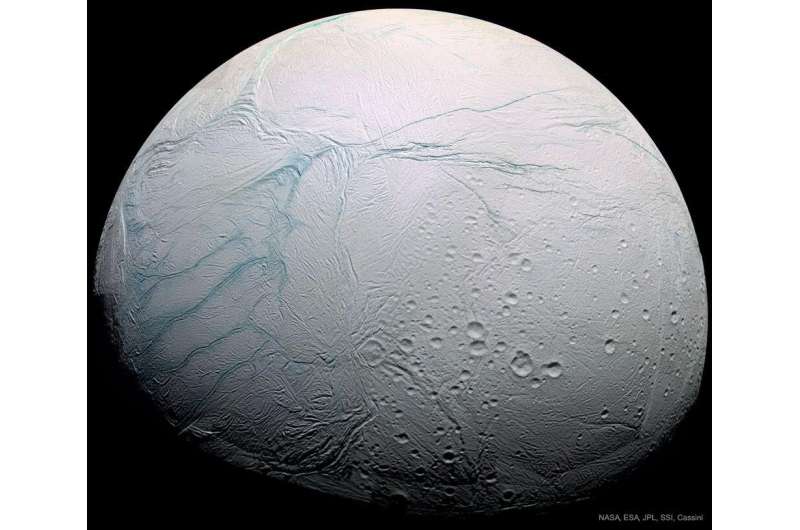In 2006, the Cassini spacecraft recorded geyser curtains shooting from “tiger stripe” fissures near the south pole of Saturn’s moon Enceladus – sometimes as much as 200 kilograms of water per second. A new study suggests how expanding ice during millennia-long cooling cycles could sometimes crack the moon’s icy shell and let its inner ocean out, providing a possible explanation for the geysers.
Enceladus has a diameter of about 504 kilometers. (For context, Earth’s diameter is 12,756 km.) The moon is covered in ice 20-30 kilometers thick, and the surface temperature is about -201 Celsius, but a decade of data from NASA’s Cassini–Huygens mission supplied evidence for a deep liquid ocean inside the icy shell, escaping into space through continuous “cryo-volcanism”. How such a small, cold world can sustain so much geological activity has been an enduring scientific puzzle.
“It captivated both the scientists’ and the general public’s attention,” said Max Rudolph, an assistant professor in geophysics at the University of California, Davis, and lead author of the study, published in Geophysical Research Letters, the American Geophysical Union’s (AGU) journal for high-impact, short-format reports with immediate implications spanning all Earth and space sciences.
Rudolph and colleagues ran a physics-based model to map the conditions that could allow the cracks from the surface to reach the ocean and cause the eruptions. The model accounts for cycles of warming and cooling that last on the scale of one hundred million years, associated with changes in Enceladus’s orbit around Saturn. During each cycle, the ice shell undergoes a period of thinning and a period of thickening. The thickening happens through freezing at the base of the ice shell, which grows downward like the ice on a lake, Rudolph said.
The pressure exerted by this downward-expanding ice on the ocean below is one mechanism researchers have proposed to explain Enceladus’s geysers. As the outer ice shell cools and thickens, pressure increases on the ocean underneath because ice has more volume than water. The increasing pressure generates stress in the ice, which could become pathways for fluid to reach the surface 20-30 kilometers away.
The new study found the ocean pressure would likely be enough to make the tiger stripe cracks seen on the surface of Enceladus. But the pressure would never be large enough to squeeze water up to the surface, when both ocean pressurization and thermal contraction are taken into consideration, they found, ruling out this proposed explanation for the geyser.
“I find interesting that the proposed model could explain the formation of an initial crack that could have led to formation of multiple cracks (tiger stripes) at the south pole of Enceladus,” said Miki Nakajima, an assistant professor of astronomy at the University of Rochester who was not involved in Rudolph’s study. She calls Rudolph’s team’s proposal “noble and promising.”
Rudolph said a mechanism first proposed by Nakajima and Andrew Ingersoll in a 2016 study can explain the eruptions. These researchers proposed water that gets into these cracks is exposed to space – Enceladus does not have an atmosphere – and spontaneously boils when it hits the vacuum.
Rudolph said this is consistent with the appearance of the surface of Enceladus, which does not show any evidence of cryo-lava flows leaking from the cracks on the surface.
https://phys.org/news/2022-03-icy-moon-enceladus-expansion-ocean.html


